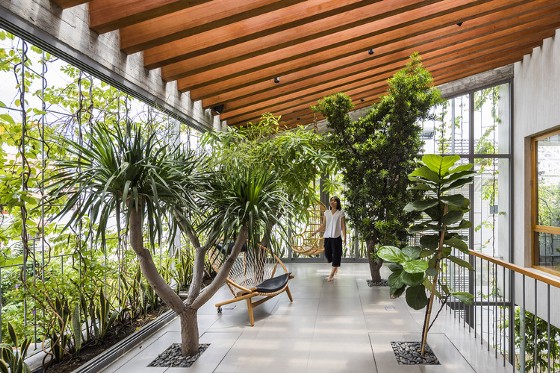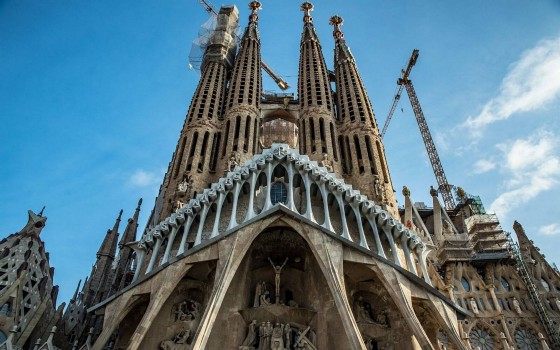Andrea Arias – Originally published: Oct 11 · 7 min read
Let’s Talk About Biophilic Design!
This article is written as a prelude to an extensive list about the future of architecture. As I was crafting the list, I realized every item needed an exclusive in depth look. So let’s talk about Biophilia.
Midway through my Master’s Degree, I had a sustainability class taught by Prof. Cynthia Fishman. She brought in regional experts in all kinds of incredible topics within sustainability that are manifesting and evolving in the Architectural World. Biophilia stood out to me because it has a lot of psychological effects to humans and a huge capacity to transform space with relatively little effort and money. The world has caught on to this, and Biophilia is one of the most adapted trends in architecture within the last 5 years (even if nobody calls it that way) — and it shows no sign of slowing down.

What is Biophilia?
Biophilia literally translates to “love of life”. In essence, it’s the idea that there is an underlining fascination and desire of communion with nature that stems for a biological imperative need to interact with the natural world.
Who used the term first?
A psychologist called Erich Fromm who coined it, but it was Harvard biologist Edward O. Wilson and Yale professor of social ecology Stephen Kellert who popularized it. Mr. Wilson wrote a book called Biophilia, in which he proposes that “our attraction to nature is genetically predetermined and a result of evolution.”
“If we stray too far from our inherited dependence on the natural world, we do so at our own peril.”
— Stephen Kellert, “Birthright: People and Nature in the Modern World” (2012)

Why does nature have this effect on us?
Research suggests that the cognitive benefits of being in nature is because nature has “restorative environments”. Why nature has this effect on us is, actually, quite a philosophical question (even while forgetting that we are nature too). Researches have gathered evidence that supports the idea that nature is so alienated from our day-to-day lives that it helps us escape from daily fatigue. The field of evolutionary psychology argue that the allure might come from the perception that those who were well-connected to their environment (landscape, animals, water sources, etc.) were more likely to survive. It is so ingrained in our human imperatives that even watching photographs or films of natural scenes have provided significant reprieve.
Studies were done comparing walking through a scenic area versus a busy urban area. The subjects in the scenic area demonstrated less anxiety than their counterparts. They also found that it really doesn’t matter how the time was spent, and how long (although they recommend 2hrs a week min.). Just a couple of minutes exposed to natural environments showed exponential mental health benefits. These benefits can include stress reduction, improved productivity, more concentration, greater creativity and self-esteem boost.

How does this apply to architecture & design?
Environmental psychology plays a huge part in the translation of the benefits. This wing of behavioral science study how natural and man made spaces affect our health, mental processes and social interactions. They have consistently suggested that the built environment supports human activity the best when it echoes the natural world. This can be achieved through scale, tone, dimension, light, layout and sound — among many other elements. Intentionally generating this type of environment can significantly curb stress and promote well-being.
Imagine if we could normalize these principles and constantly integrate them in the built environment?
Is this a Sustainability Thing?
It is mainly about human health, but biophilia does inherently have a lot of sustainability embedded in it specially if you make it a mission to use as many locally sourced materials as possible.
Patterns of Biophilic Design
This section utilizes Terrapin’s Bright-Green Resource extensively as a guideline to present diverse ideas within Biophilic Design. The information will be accompanied by curated images, and short comments to further clarify.
Nature in The Space:

01// Visual Connection — this is exactly what it implies, a view into nature, living system and natural processes.

02// Non-Visual Connection with Nature — these are auditory, haptic, olfactory and gustatory stimuli. They have to cultivate positive reference to natural systems, nature or natural process.
Think listening to a recording of waves or rain. Think of subtle architectural queues within an enclosed place. And definitely think of Biomimicry.

03// Non-Rhythmic Sensory Stimuli — Ephemeral phenomena with nature that may be statistical, but no precisely predictable.
The wind. A sudden storm. A bird flew past your window. Including those sensations in the design or enabling those phenomena to occur within your space is part of exciting serendipity that confirms life is worth living.

04// Thermal & Airflow Variability — Subtle changes in the air temperature, relative humidity and airflow. These aspects acting on your skin and the temperature of surfaces in a way that mimics natural environments.

05// Presence of Water — Seeing, hearing or touching water.

06// Dynamic & Diffuse Light — Varying light and shadow intensities that change over time, mimicking

07// Connection with Natural Systems — Awareness of seasonal and temporal changes.
Natural Analogues:


08// Biomorphic Forms & Patterns — symbolic references (contours, patterns, texture, numerical arrangements) that persist in nature.
The interior structure, its columns and nave, are meant to mimic the shape of bones of a skeleton and the shape of trees and branches.


09// Material Connection with Nature — Materials and elements from nature that have minimal processing and reflect the local ecology and geology, hearkening to its unique sense of place.

10// Complexity & Order — Sensory information that adheres to spatial hierarchy as it might be found and encountered in nature.
Nature of the Space:

11// Prospect — Unimpeded view over a distance.

12// Refuge — A place for withdrawal from environmental conditions, yes, but also from the main flow of activity of the space. It’s important to create spaces that the individual is protected from behind and overhead.

13// Mystery — Promise of more information. This is achieved from partial views, strategic deprivation of sensorial devices that entice individuals to travel deeper and explore the environment they are in.

14// Risk/Peril — Identifiable threat coupled with reliable safeguard.
This is not about just bringing a couple of plants in, even though it is definitely a step in the right direction. What it’s really about is reconnecting with nature, and rekindling that aspect of our humanity by advocating more biophilic buildings. Biophilic design, above all, fosters an identity of place through authentic interaction with natural elements. Every place in which employs biophilic design will respond to circumstances unique to that place — rendering it its authenticity. You can incorporate all of these elements to big and small places alike. From your home to the local library, Biophilia is a new way of thinking of space that celebrates our need to connect with nature.

Leave a comment